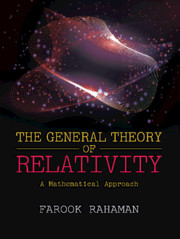Book contents
- Frontmatter
- Dedication
- Contents
- List of Figures
- List of Tables
- Preface
- Acknowledgments
- Chapter 1 Tensor Calculus — A Brief Overview
- Chapter 2 Geodesic
- Chapter 3 Einstein Field Equations
- Chapter 4 Linearized Gravity
- Chapter 5 Lie Derivatives and Killing’s Equation
- Chapter 6 Spacetimes of Spherically Symmetric Distribution of Matter and Black Holes
- Chapter 7 Particle and Photon Orbits in the Schwarzschild Spacetime
- Chapter 8 Causal Structure of Spacetime
- Chapter 9 Exact Solutions of Einstein Equations and Their Causal Structures
- Chapter 10 Rotating Black Holes
- Chapter 11 Elementary Cosmology
- Chapter 12 Elementary Astrophysics
- Appendix A Extrinsic Curvature or Second Fundamental Form
- Appendix B Lagrangian Formulation of General Relativity
- Appendix C 3+1 Decomposition
- Bibliography
- Index
Chapter 5 - Lie Derivatives and Killing’s Equation
Published online by Cambridge University Press: 24 March 2021
- Frontmatter
- Dedication
- Contents
- List of Figures
- List of Tables
- Preface
- Acknowledgments
- Chapter 1 Tensor Calculus — A Brief Overview
- Chapter 2 Geodesic
- Chapter 3 Einstein Field Equations
- Chapter 4 Linearized Gravity
- Chapter 5 Lie Derivatives and Killing’s Equation
- Chapter 6 Spacetimes of Spherically Symmetric Distribution of Matter and Black Holes
- Chapter 7 Particle and Photon Orbits in the Schwarzschild Spacetime
- Chapter 8 Causal Structure of Spacetime
- Chapter 9 Exact Solutions of Einstein Equations and Their Causal Structures
- Chapter 10 Rotating Black Holes
- Chapter 11 Elementary Cosmology
- Chapter 12 Elementary Astrophysics
- Appendix A Extrinsic Curvature or Second Fundamental Form
- Appendix B Lagrangian Formulation of General Relativity
- Appendix C 3+1 Decomposition
- Bibliography
- Index
Summary
Introduction
The Lie derivative is a significant concept of differential geometry, named after the discovery by Sophus Lie in the late nineteenth century. It estimates the modification of a tensor field (containing scalar function, vector field), along the flow defined by an additional vector field. Lie derivative can be defined on any differentiable manifold as this change is coordinate invariant.
A vector field X is a linear mapping from C∞ function to C∞ function on a manifold, satisfying
such that
Suppose Xμ(x) is a vector field defined over a manifold M. Trajectory of Xμ is obtained by solving
Let us consider a coordinate transformation
where ε is a parameter. This is known as one parameter set of transformation. This transformation designates a mapping of the spacetime onto itself. If the transformation takes the form
then it is called infinitesimal one parameter transformation or infinitesimal mapping. Here, ξμ(x) is a contravariant vector field defined by
[Infinitesimal mapping means that for each point P(xμ) of the spacetime there corresponds another neighboring point Q(xμ + εξμ) in the same coordinate system (see Fig. 10).]
Suppose a tensor T(x) defined in our spacetime. At the point Q, one can assess the tensor (T.x) in two different ways:
1. One can have the value of T at Q, i.e., T(xμ).
2. The T(xμ) can be obtained as transmuted tensor T using normal coordinate.
Thus, transformation for tensor at the point Q has two techniques. The difference among these two values of the tensor calculated at the point Q(xμ) hints to the concept of Lie derivative of the tensor T. One can differentiate the functions, tensor fields with respect to a vector field.
Lie Derivative of a Scalar
Let at point Q, the value of scalar ϕ(x) be ϕ(x), i.e.,
[neglecting higher power of ε]
Also, transformation of scalar function ϕ(x) remains unaffected. Thus,
One can define the Lie derivative of scalar function ϕ(x) (denoted as Lξϕ) as
As ϕ is a scalar, therefore, then partial derivative can be replaced by a covariant derivative to yield,
- Type
- Chapter
- Information
- The General Theory of RelativityA Mathematical Approach, pp. 95 - 114Publisher: Cambridge University PressPrint publication year: 2021



